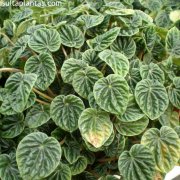Care of the indoor plant Peperomia caperata or Emerald ripple peperomia |
|
The genus Peperomia, family Piperaceae, includes more than 1000 species of perennial plants native to tropical regions around the globe. Some species are: Peperomia caperata, Peperomia argyreia, Peperomia angulata, Peperomia magnoliifolia, Peperomia polybotrya, Peperomia obtusifolia, Peperomia axillaris, Peperomia dolabriformis. Common name: Emerald ripple peperomia. This species is native to Brazil. They are small herbaceous plants of compact size that reach 25 cm (9.84") in height. The fleshy leaves are heart-shaped, rough in texture and glossy dark green (there are variegated and maroon varieties). They produce erect white flower spikes up to 15 cm (5.9") tall. They can bloom from spring to late fall. Emerald ripple peperomia is used as indoor and greenhouse plants; In summer it can be located outdoors always in the shade and protected from the rain because it is not advisable for the leaves to get wet. Peperomia caperata needs a well-lit exposure but no direct sun. The temperature must not be lower than 18 ºC (64.4 ºF). The soil can be a commercial houseplant substrate or a garden soil mixed with 1/3 heather soil and 1/3 coarse sand. The transplant is done in autumn or mid-winter; transplant every two years. Water moderately, waiting until the substrate is completely dry. Water by immersion in lime-free water for one hour. The humidity must be high: place a plate with damp pebbles under the pot and periodically spray the leaves with lime-free water in summer. Fertilize every 3 weeks in spring and summer with mineral fertilizer for indoor plants at half the usual dose. Prune faded flowers. Peperomia caperata is a resistant plant to the usual pests and diseases. Emerald ripple peperomia is propagated in spring by division and by stem or leaf cuttings. |
Images of the indoor plant Peperomia caperata or Emerald ripple peperomia |
Find plants
Peperomia caperata or Emerald ripple peperomia | Care and Growing
© 2025 FavThemes




